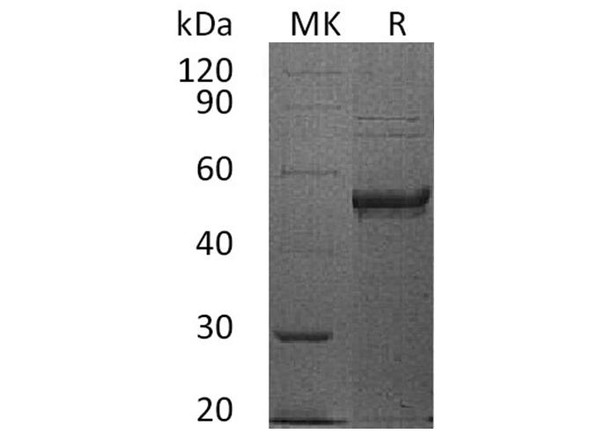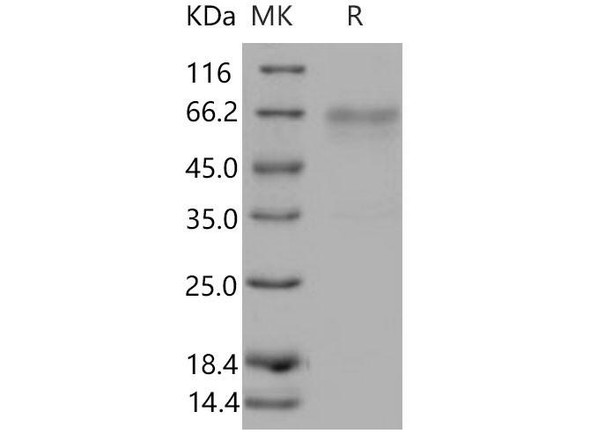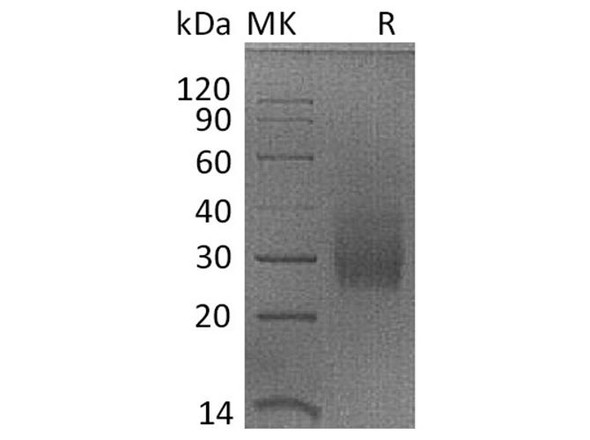Description
| Product Name: | Human TNFRSF14 Recombinant Protein |
| Product Code: | RPPB1034 |
| Size: | 25µg |
| Species: | Human |
| Target: | TNFRSF14 |
| Synonyms: | Tumor Necrosis Factor Receptor Superfamily Member 14, HVEM, TR2, Herpes Virus Entry Mediator A, Tumor Necrosis Factor Receptor-Like 2, Herpesvirus Entry Mediator, HVEA, ATAR, CD270, LIGHTR, CD40-Like Protein, Tumor Necrosis Factor Receptor-Like Gene2. |
| Source: | Escherichia Coli |
| Physical Appearance: | Sterile filtered colorless solution. |
| Formulation: | The TNFRSF14 solution (0.5mg/ml) containing 20mM Tris-HCl (pH 8.0), 0.1M NaCl and 10% glycerol. |
| Stability: | Store at 4°C if entire vial will be used within 2-4 weeks.�Store, frozen at -20°C for longer periods of time.�For long term storage it is recommended to add a carrier protein (0.1% HSA or BSA).Avoid multiple freeze-thaw cycles. |
| Purity: | Greater than 85% as determined by SDS-PAGE. |
| Amino Acid Sequence: | MGSSHHHHHH SSGLVPRGSH MGSLPSCKED EYPVGSECCP KCSPGYRVKE ACGELTGTVC EPCPPGTYIA HLNGLSKCLQ CQMCDPAMGL RASRNCSRTE NAVCGCSPGH FCIVQDGDHC AACRAYATSS PGQRVQKGGT ESQDTLCQNC PPGTFSPNGT LEECQHQTKC SWLVTKAGAG TSSSHWV |
TNFRSF14, a member of the TNF receptor superfamily, is a type I transmembrane protein. TNFRSF14 is expressed in peripheral blood T cells, B cells, monocytes and in various tissues enriched in lymphoid cells. TNFRSF14 operates as a co-stimulatory factor for the activation of lymphoid cells and as a deterrent to infection by herpesvirus. Additionally, TNFRSF14 encourages the proliferation of T cells, and triggers apoptosis of various tumor cells.�
TNFRSF14 Human Recombinant produced in E. Coli is a single, glycosylated polypeptide chain containing 187 amino acids (39-202) and having a molecular mass of 19.7kDa.TNFRSF14 is fused to a 23 amino acid His-tag at N-terminus & purified by proprietary chromatographic techniques.
| UniProt Protein Function: | TNFSF14: Cytokine that binds to TNFRSF3/LTBR. Binding to the decoy receptor TNFRSF6B modulates its effects. Activates NFKB, stimulates the proliferation of T-cells, and inhibits growth of the adenocarcinoma HT-29. Acts as a receptor for Herpes simplex virus. Belongs to the tumor necrosis factor family. 2 isoforms of the human protein are produced by alternative splicing. |
| UniProt Protein Details: | Protein type:Membrane protein, integral; Cytokine; Inhibitor Chromosomal Location of Human Ortholog: 19p13.3 Cellular Component: extracellular space; cytoplasm; plasma membrane; integral to membrane Molecular Function:protein binding; caspase inhibitor activity; cytokine activity; tumor necrosis factor receptor binding; receptor binding Biological Process: release of cytoplasmic sequestered NF-kappaB; T cell proliferation; T cell activation; apoptosis; T cell costimulation; T cell homeostasis; immune response; negative regulation of caspase activity; signal transduction; positive regulation of myoblast differentiation |
| NCBI Summary: | The protein encoded by this gene is a member of the tumor necrosis factor (TNF) ligand family. This protein is a ligand for TNFRSF14, which is a member of the tumor necrosis factor receptor superfamily, and which is also known as a herpesvirus entry mediator (HVEM). This protein may function as a costimulatory factor for the activation of lymphoid cells and as a deterrent to infection by herpesvirus. This protein has been shown to stimulate the proliferation of T cells, and trigger apoptosis of various tumor cells. This protein is also reported to prevent tumor necrosis factor alpha mediated apoptosis in primary hepatocyte. Two alternatively spliced transcript variant encoding distinct isoforms have been reported. [provided by RefSeq, Jul 2008] |
| UniProt Code: | O43557 |
| NCBI GenInfo Identifier: | 313104028 |
| NCBI Gene ID: | 8740 |
| NCBI Accession: | O43557.2 |
| UniProt Secondary Accession: | O43557,O75476, Q6FHA1, Q8WVF8, Q96LD2, A8K7M2, C9J5H4 |
| UniProt Related Accession: | O43557 |
| Molecular Weight: | 22,395 Da |
| NCBI Full Name: | Tumor necrosis factor ligand superfamily member 14 |
| NCBI Synonym Full Names: | tumor necrosis factor (ligand) superfamily, member 14 |
| NCBI Official Symbol: | TNFSF14�� |
| NCBI Official Synonym Symbols: | LTg; TR2; CD258; HVEML; LIGHT�� |
| NCBI Protein Information: | tumor necrosis factor ligand superfamily member 14; delta transmembrane LIGHT; herpesvirus entry mediator A; herpesvirus entry mediator ligand; herpesvirus entry mediator-ligand; herpes virus entry mediator ligand; ligand for herpesvirus entry mediator; tumor necrosis factor receptor-like 2; tumor necrosis factor superfamily member LIGHT |
| UniProt Protein Name: | Tumor necrosis factor ligand superfamily member 14 |
| UniProt Synonym Protein Names: | Herpes virus entry mediator ligand; HVEM-L; Herpesvirus entry mediator ligand; CD_antigen: CD258Cleaved into the following 2 chains:Tumor necrosis factor ligand superfamily member 14, membrane form; Tumor necrosis factor ligand superfamily member 14, soluble form |
| Protein Family: | Light-induced protein |
| UniProt Gene Name: | TNFSF14�� |
| UniProt Entry Name: | TNF14_HUMAN |










